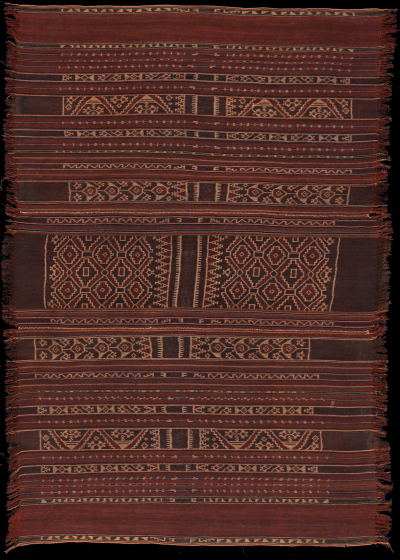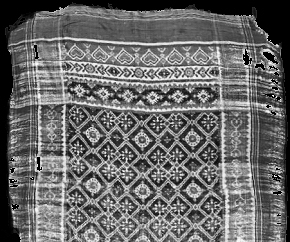| |
 
 | | | |
119 Solor Archipelago, Lembata
Kewatek (sarong)  
| | Locale: | Atadei. Lamaholot people. | | Period: | 19th or very early 20th c. | | Yarn: | Cotton, hand-spun, coarse | | Technique: | Warp ikat | | Panels: | 3 | | Size: | 121 x 182 cm (3' 11" x 5' 11") LW: 1.50 | | Weight: | 850 g (30.0 oz), 386 g/m2 (1.26 oz/ft2) | | Design: | Petak haren nai telo, three panel bridewealth sarong. Midfield with patola ratu, flanked by bands with with moku (sting rays) ending in small tumpal patterns. Two bands with V-shaped motifs representing Lembata's emblematic peledang, the outrigger canoe used in whaling, or a smaller paddled boat called tena. Ecru and morinda red on maroon. Midfield inspired by patola such as this one, probably 18th c., collected in Indonesia, auctioned by Charles A. Whitaker, circa 2010.
 | | Comment: | Atadei bridewealth sarong of extraordinary quality and historical importance. Weaving far tighter than common on Lembata (which normally is quite 'kasar'). Narrow accent stripes in silk, which was commonly used on Kedang kewatek made in Ili Api and on Adonara, but very rarely in Atadei. Typical for Atadei is that all indigo has been overdyed with morinda, a process called belapit, creating a very dark tone similar to eggplant. As Atadei, unlike Lamalera, just across the bay, is not a whaling village, it is likely that here the V-shaped motif is not interpreted as peledang as it is in Lamalera, but, as Robyn Maxwell writes in Textiles of Southeast Asia, and Ruth Barnes in To Speak With Cloth, a boat with paddles called tena. Its historical origin is probably the rigging of a boat. Ex collection Verra Darwiko. | | Background: | Chapters on Solor Archipelago and Lembata. | | Exhibited: | Museu do Oriente, Lisbon, 2014/15.
Hong Kong University Museum and Art Gallery, 2017. | | Published: |
Woven Languages, 2014.
Ikat Textiles of the Indonesian Archipelago, 2018.
| | Compare: | 115 131 047 126 048 | | Sources: | Very similar to petak haren nai telo in Gittinger, To Speak With Cloth, Plate 5. Very similar to other bridewealth sarong depicted in Khan Majlis's supplement to Voelger and Von Welck, Indonesian Textiles, Fig. 148, and to one in Tropenmuseum from before 1940, Nr. 1772-1179, though ours has richer decoration in top and bottom panels, including the boats. Midfield similar to cloth from collection Kent Watters, depicted in Hamilton, Gift of the Cotton Maiden, Fig. 8-22, and to patola in Khan Majlis, Woven Messages, Fig. 5. Overall similarity to Atadei sarong identified as petak haren nai telo in Museum für Völkerkunde, Vienna, depicted in Leigh-Theisen and Mittersaksenschmöller, Lebensmuster, Abb. 147. See also John Guy, Woven Cargoes, Fig. 52. | | |

©Peter ten Hoopen, 2025
All rights reserved.
|
|


